苏州大学:物理科学与技术学院物理学专业《电动力学》课程教学大纲(英文)
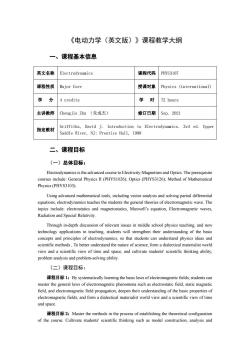
《电动力学(英文版)》课程教学大纲 一、课程基本信息 英文名称Electrodynamics 课程代码 PHYS3107 课程性质Major Core 授课对象 Physics (international) 学分 4 credits 学时 72 hours 主讲教师 Chengjie Zhu(朱成杰) 修订日期 Sep.2021 指定教材 Griffiths,David J.Introduction to Electrodynamics.3rd ed.Upper Saddle River,NJ:Prentice Hall,1998 二、课程目标 (一)总体目标: is the i-Mnetimnd The courses include:General Physics II(PHYS1026).Optics(PHYS3126),Method of Mathematical Physics(PHYS3103). Using advanced mathematical tools.including vector analysis and solving partial differential teaches the students the eral theores of ele magnetic wave.The topics include: electrostatics and magnetostatics,Maxwell'sq Electromagnetic waves. Radiation and Special Relativity. Through in-depth discussion of relevant issues in middle school physics teaching.and new technology applications in teaching.students will strengthen their understanding of the basic view and a scientific view of time and space,and cultivate students'scientific thinking ability. problem analysis and problem-solving ability. (二)课程目标: i课程目标l:By systematically eaming the basic aws fields,studentsca mas ster the general laws of electromagnetic phenomena such as electrostatic field,static magneti field,and electromagnetic field propagation,deepen their understanding of the basic properties of electromagnetic fields,and form a dialectical materialist world view and a scientific view of time and space. of the cours.Cultivate students thinking such as,analysis and
《电动力学(英文版)》课程教学大纲 一、课程基本信息 英文名称 Electrodynamics 课程代码 PHYS3107 课程性质 Major Core 授课对象 Physics (international) 学 分 4 credits 学 时 72 hours 主讲教师 Chengjie Zhu (朱成杰) 修订日期 Sep. 2021 指定教材 Griffiths, David J. Introduction to Electrodynamics. 3rd ed. Upper Saddle River, NJ: Prentice Hall, 1998 二、课程目标 (一)总体目标: Electrodynamics is the advanced course to Electricity-Magnetism and Optics. The prerequisite courses include: General Physics II (PHYS1026); Optics (PHYS3126); Method of Mathematical Physics (PHYS3103). Using advanced mathematical tools, including vector analysis and solving partial differential equations, electrodynamics teaches the students the general theories of electromagnetic wave. The topics include: electrostatics and magnetostatics, Maxwell’s equation, Electromagnetic waves, Radiation and Special Relativity. Through in-depth discussion of relevant issues in middle school physics teaching, and new technology applications in teaching, students will strengthen their understanding of the basic concepts and principles of electrodynamics, so that students can understand physics ideas and scientific methods , To better understand the nature of science, form a dialectical materialist world view and a scientific view of time and space, and cultivate students' scientific thinking ability, problem analysis and problem-solving ability. (二)课程目标: 课程目标 1:By systematically learning the basic laws of electromagnetic fields, students can master the general laws of electromagnetic phenomena such as electrostatic field, static magnetic field, and electromagnetic field propagation, deepen their understanding of the basic properties of electromagnetic fields, and form a dialectical materialist world view and a scientific view of time and space. 课程目标 2:Master the methods in the process of establishing the theoretical configuration of the course. Cultivate students' scientific thinking such as model construction, analysis and
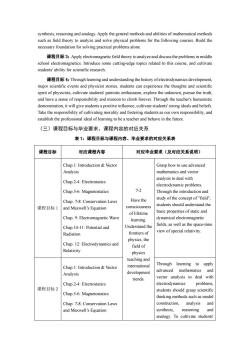
synthesis,reasoning and analogy.Apply the general methods and abilities of mathematical methods such as field theory to analyze and solve physical problems for the following courses.Build the foundation for soving practical 课程目标3:Apply electromagnetic field theory to analyze and discuss the problems inmiddl school electromagnetics.Introduce some cutting-edge topics related to this course,and cultivate students'ability for scientific research. 课程目标4 Through and understanding the history developmen major events and physicist stories,students can the thoughts and spirit of physicists,cultivate students'patriotic enthusiasm,explore the unknown,pursue the truth and have a sense of responsibility and mission to climb forever.Through the teacher's humanistic demonstration,it will give students a positive influence,cultivate students'strong ideals and beliefs. Take the responsibility of cultivating morality and fostering students asou own responsibility,and establish the professional ideal of leaming to bea teacher and behave in the future (三)课程目标与毕业要求、课程内容的对应关系 表1:课程目标与课程内容、单业要求的对应关系表 课程目标 对应课程内容 对应毕业要求(及对应关系说明) Chap.1:Introduction Vector Grasp how to use advanced Analysis mathematics and vector analysis to deal with Chap.2-4:Electrostatics problem Chap5-:Magnetostatics 7-2 Through the introductionan Have the study of the concept of "field" Chap.7-8:Conservation Laws students should understand the 课程目标1 and Maxwel's Equation consciousness of lifetime basic properties of static and Chap.9:Electromagnetic Wave learning. Chap.10-11:Potential and Understand the fields.as well as the space-tim view of special relativity. Radiation physics.the Chap.12:Electrodynamics and field of Relativity physics teaching and Chap.1:Introduction Vector Through learning to apply Analysis development advanced mathematics and vector analysis to deal with trends. Chap2-:Electrostatics electrodynamics problems 课程目标2 Chap5-:Magnetostatics students should grasp thinking methods such as mode Chap.7-8:Conservation Laws construction.analysis and and Maxwell's Equation synthesis, reasoning and analogy.To cultivate students
synthesis, reasoning and analogy. Apply the general methods and abilities of mathematical methods such as field theory to analyze and solve physical problems for the following courses. Build the necessary foundation for solving practical problems alone. 课程目标 3:Apply electromagnetic field theory to analyze and discuss the problems in middle school electromagnetics. Introduce some cutting-edge topics related to this course, and cultivate students' ability for scientific research. 课程目标 4:Through learning and understanding the history of electrodynamics development, major scientific events and physicist stories, students can experience the thoughts and scientific spirit of physicists, cultivate students' patriotic enthusiasm, explore the unknown, pursue the truth, and have a sense of responsibility and mission to climb forever. Through the teacher's humanistic demonstration, it will give students a positive influence, cultivate students' strong ideals and beliefs. Take the responsibility of cultivating morality and fostering students as our own responsibility, and establish the professional ideal of learning to be a teacher and behave in the future. (三)课程目标与毕业要求、课程内容的对应关系 表 1:课程目标与课程内容、毕业要求的对应关系表 课程目标 对应课程内容 对应毕业要求(及对应关系说明) 课程目标 1 Chap.1: Introduction & Vector Analysis Chap.2-4: Electrostatics Chap.5-6: Magnetostatics Chap. 7-8: Conservation Laws and Maxwell’s Equation Chap. 9: Electromagnetic Wave Chap.10-11: Potential and Radiation Chap. 12: Electrodynamics and Relativity 7-2 Have the consciousness of lifetime learning. Understand the frontiers of physics, the field of physics teaching and international development trends. Grasp how to use advanced mathematics and vector analysis to deal with electrodynamic problems. Through the introduction and study of the concept of "field", students should understand the basic properties of static and dynamical electromagnetic fields, as well as the space-time view of special relativity. 课程目标 2 Chap.1: Introduction & Vector Analysis Chap.2-4: Electrostatics Chap.5-6: Magnetostatics Chap. 7-8: Conservation Laws and Maxwell’s Equation Through learning to apply advanced mathematics and vector analysis to deal with electrodynamics problems, students should grasp scientific thinking methods such as model construction, analysis and synthesis, reasoning and analogy. To cultivate students
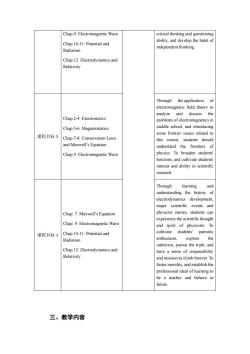
Chap.9:Electromagnetic Wave critical thinking and questioning Chap.10-11:Potential and ability,and developthe habit Radiation ndependent thinking Chap.12:Electrodynamics and Relativity Through the application electromagnetic field theory to analyze and discuss the Chap2-:Electrostatics problems ofelectromagnetics in Chap.5-:Magnetostatics middle school,and introducing 课程目标 some frontier issues related to Chap 7-8:Conservation Laws this course, students should and Maxwell's Equation understand the frontiers of Chap.9:Electromagnetic Wave physics.To broaden students horizons,and cultivate students interest and ability in scientific research. Through learning and understanding the history of electrodynamics development. major scientific events and Chap.7:Maxwell's Equation physicist stories,students can Chap.9:Electromagnetic Wave experience the scientific thought and spirit of physicists.To 课程目标4Chap.l0-Il:Potential and cultivate studentspatriotic Radiation enthusiasm, explore the Chap.12:Electrodynamics and have a sense of responsibility Relativity and mission to climb forever.To foster morality,and establish the professional ideal of learning to be a teacher and behave future 三、教学内容
Chap.9: Electromagnetic Wave Chap.10-11: Potential and Radiation Chap.12: Electrodynamics and Relativity critical thinking and questioning ability, and develop the habit of independent thinking. 课程目标 3 Chap.2-4: Electrostatics Chap.5-6: Magnetostatics Chap.7-8: Conservation Laws and Maxwell’s Equation Chap.9: Electromagnetic Wave Through the application of electromagnetic field theory to analyze and discuss the problems of electromagnetics in middle school, and introducing some frontier issues related to this course, students should understand the frontiers of physics. To broaden students' horizons, and cultivate students' interest and ability in scientific research. 课程目标 4 Chap. 7: Maxwell’s Equation Chap. 9: Electromagnetic Wave Chap.10-11: Potential and Radiation Chap.12: Electrodynamics and Relativity Through learning and understanding the history of electrodynamics development, major scientific events and physicist stories, students can experience the scientific thought and spirit of physicists. To cultivate students' patriotic enthusiasm, explore the unknown, pursue the truth, and have a sense of responsibility and mission to climb forever. To foster morality, and establish the professional ideal of learning to be a teacher and behave in future. 三、教学内容
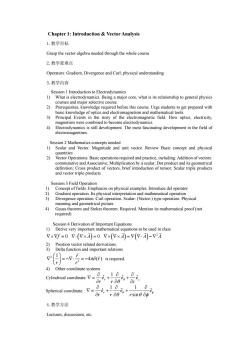
Chapter 1:Introduction Vector Analysis 1.教学目标 Grasp the vector algebra needed through the whole course 2.教学重难点 Operators:Gradient.Divergence and Curl:physical understanding 3.教学内容 2) 3)Principal Events in the story of the tromagnetic field.How optics.electricity. re co rody 4④ nating development in the field of 1 ve Revic hale conp n 2 Math 2) o Additio 一caneaorCfpeOoaleitofectors.bicfntotdctionofienotscalrtpitepotdhcts roduce del operator Divergence operation.Curl operation.Scalar-(Vector-)type operation.Physical 4) eanin g and gec eorem.Required.Mention its mathematical proof(no required) 7×=0(×A)=0V×(×A)=(.A)-A Position vector related derivation Delta function and important relations /-. .3 --4πd(f)is required 4) Other coordinate system Cylindrical coordinate: 88* 10 r0g%+ sin 4.教学方法 Lectures,discussions,etc
Chapter 1: Introduction & Vector Analysis 1.教学目标 Grasp the vector algebra needed through the whole course 2.教学重难点 Operators: Gradient, Divergence and Curl; physical understanding 3.教学内容 Session 1 Introduction to Electrodynamics 1) What is electrodynamics. Being a major core, what is its relationship to general physics courses and major selective course. 2) Prerequisites, knowledge required before this course. Urge students to get prepared with basic knowledge of optics and electromagnetism and mathematical tools. 3) Principal Events in the story of the electromagnetic field. How optics, electricity, magnetism were combined to become electrodynamics. 4) Electrodynamics is still development. The most fascinating development in the field of electromagnetism. Session 2 Mathematics concepts needed 1) Scalar and Vector. Magnitude and unit vector. Review Basic concept and physical quantities 2) Vector Operations: Basic operations required and practice, including: Addition of vectors: commutative and Associative; Multiplication by a scalar; Dot product and its geometrical definition; Cross product of vectors, brief introduction of tensor; Scalar triple products and vector triple products Session 3 Field Operation 1) Concept of fields. Emphasize on physical examples. Introduce del operator 2) Gradient operation. Its physical interpretation and mathematical operation 3) Divergence operation. Curl operation. Scalar- (Vector-) type operation. Physical meaning and geometrical picture. 4) Gauss theorem and Stokes theorem. Required. Mention its mathematical proof (not required) Session 4 Derivation of Important Equations 1) Derive very important mathematical equations to be used in class f 0 A 0 2 A AA 2) Position vector related derivations. 3) Delta function and important relations 2 3 1 4 () r r r r is required. 4) Other coordinate systems Cylindrical coordinate: 1 ˆ ˆ ˆ r z e ee rr z Spherical coordinate: 1 1 ˆ ˆ ˆ sin r ee e rr r 4.教学方法 Lectures, discussions, etc
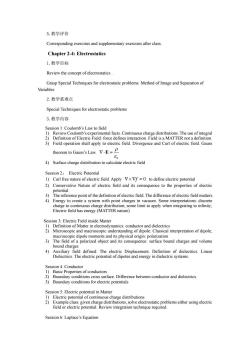
5.教学评价 Corresponding exercises and supplementary exercises after class Chapter 2-4:Electrostatics 1.教学目标 Review the concept of electrostatics Grasp Special Techniques for electrostatic problems:Method of Image and Separation of Variables 2.教学重难点 Special Techniques for electrostatic problems 3.教学内容 al facts Continuous ch e distributions The use of integral 3)Field operation shall apply to electric field.Divergence and Curl of electric field.Gauss theorem to Gauss's Law.V.E=P 4)Surface charge distribution to calculate electric field Session2: Electric Po 1)Curl free nature of electric field.Apply Vx=to define electric potential 2)Conservative Nature of electric field and its consequence to the properties of electric Thereference pont of thedefntionffield.Thefferefiematters 4)Energy to create a syste Electric field has energy (MATTER nature) :1 namics:conductor and dielectrics 2)Microscopic and macroscopic understanding of dipole:Classical interpretation of dipole ound charges and volume bound charg defined electric poten 2)Boundary conditions cross surface.Difference between conductor and dielectrics. 3)Boundary conditions for electric potentials Session 5 Flectrie notential in Matter ential of continuous charge distributions eopec eelCPabltemseiherusingelectnc Session 6:Laplace's Equation
5.教学评价 Corresponding exercises and supplementary exercises after class. Chapter 2-4: Electrostatics 1.教学目标 Review the concept of electrostatics . Grasp Special Techniques for electrostatic problems: Method of Image and Separation of Variables 2.教学重难点 Special Techniques for electrostatic problems 3.教学内容 Session 1: Coulomb’s Law to field 1) Review Coulomb’s experimental facts. Continuous charge distributions. The use of integral 2) Definition of Electric Field: force defines interaction. Field is a MATTER not a definition. 3) Field operation shall apply to electric field. Divergence and Curl of electric field. Gauss theorem to Gauss’s Law. 0 E 4) Surface charge distribution to calculate electric field Session 2: Electric Potential 1) Curl free nature of electric field. Apply f 0 to define electric potential 2) Conservative Nature of electric field and its consequence to the properties of electric potential. 3) The reference point of the definition of electric field. The difference of electric field matters. 4) Energy to create a system with point charges in vacuum. Some interpretations: discrete charge to continuous charge distribution; some limit to apply when integrating to infinity; Electric field has energy (MATTER nature) Session 3: Electric Field inside Matter 1) Definition of Matter in electrodynamics: conductor and dielectrics 2) Microscopic and macroscopic understanding of dipole: Classical interpretation of dipole; macroscopic dipole moments and its physical origin: polarization 3) The field of a polarized object and its consequence: surface bound charges and volume bound charges 4) Auxiliary field defined: The electric Displacement. Definition of dielectrics. Linear Dielectrics. The electric potential of dipoles and energy in dielectric systems. Session 4: Conductor 1) Basic Properties of conductors 2) Boundary conditions cross surface. Difference between conductor and dielectrics. 3) Boundary conditions for electric potentials Session 5: Electric potential in Matter 1) Electric potential of continuous charge distributions 2) Example class: given charge distributions, solve electrostatic problems either using electric field or electric potential. Review integration technique required. Session 6: Laplace’s Equation
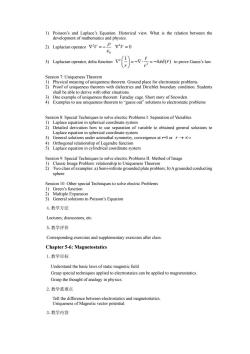
1)Poisson's and Laplace's Equation.Historical view.What is the relation between the development of mathematics and physics. 2)Laplacian operator=-P=0 7.Ini 2)Proof ofq ess the rem with dielectrics and Dirichlet boundary condition.Students hall be 4)Examples to use uniqueness theorem to"guess out"solutions to electrostatic problems Lappcal Techniques to solve electric Problems 1:Separationo on in sp Laplace ation in spherical coordinate variable to obtained general solutions to vstem ns under a☑ zimuthal symmetry,convergence at -0or stem )ooundd oducine sphere Session 10:Other special Techniques to solve electric Problems 》Green's.Function eeroisquio 4.教学方法 Lectures.discussions.ete 5.教学评价 Corresponding exercises and supplementary exercises after class Chapter 5-6:Magnetostatics 1.教学目标 Understand the basic as of static magnetic field Grasp special techniques applied to electrostatics can be applied to magnetostatics. Grasp the thought of analogy in physics. 2.教学重难点 Tell the difference between electrostatics and magnetostatics Uniqueness of Magnetic vector potential. 3.教学内容
1) Poisson’s and Laplace’s Equation. Historical view. What is the relation between the development of mathematics and physics. 2) Laplacian operator 2 0 V 2 V 0 3) Laplacian operator, delta function 2 3 1 4 () r r r r to prove Gauss’s law. Session 7: Uniqueness Theorem 1) Physical meaning of uniqueness theorem. Ground place for electrostatic problems. 2) Proof of uniqueness theorem with dielectrics and Dirichlet boundary condition. Students shall be able to derive with other situations. 3) One example of uniqueness theorem: Faraday cage. Short story of Snowden. 4) Examples to use uniqueness theorem to “guess out” solutions to electrostatic problems Session 8: Special Techniques to solve electric Problems I: Separation of Variables 1) Laplace equation in spherical coordinate system 2) Detailed derivation how to use separation of variable to obtained general solutions to Laplace equation in spherical coordinate system 3) General solutions under azimuthal symmetry, convergence at r=0 or r r 4) Orthogonal relationship of Legendre function 5) Laplace equation in cylindrical coordinate system Session 9: Special Techniques to solve electric Problems II: Method of Image 1) Classic Image Problem: relationship to Uniqueness Theorem 2) Two class of examples: a) Semi-infinite grounded plate problem; b) A grounded conducting sphere Session 10: Other special Techniques to solve electric Problems 1) Green’s function 2) Multiple Expansion 3) General solutions to Poisson’s Equation 4.教学方法 Lectures, discussions, etc. 5.教学评价 Corresponding exercises and supplementary exercises after class. Chapter 5-6: Magnetostatics 1.教学目标 Understand the basic laws of static magnetic field Grasp special techniques applied to electrostatics can be applied to magnetostatics. Grasp the thought of analogy in physics. 2.教学重难点 Tell the difference between electrostatics and magnetostatics. Uniqueness of Magnetic vector potential. 3.教学内容
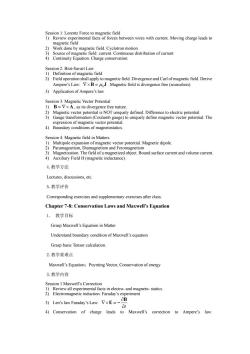
ld:current arge conserat 2)Field operation shallan oly to magnetic field Divergence and Curl of magnetic field Derive AmpereMagnetie field is divergence free (sourceless) 3)Application of Ampere's law Vector Potentia as 3)Gauge transformation (Coulumb gau ge)to uniquely define magnetic vector potential.The 4) The field ofa magnetized objeet.Bound surface come ct 4.教学方法 Lectures,discussions,etc. 5.教学评价 Corresponding exercises and supplementary exercises after class Chapter 7-8:Conservation Laws and Maxwell's Equation 1.教学目标 Grasp Maxwell's Equation in Matter Understand boundary condition of Maxwell'seqution Grasp basic Tensor calculation. 2.教学重难点 Maxwell's Equation:Poynting Vector,Conservation of energy 3.教学内容 )E室 4)Conservation of charge leads to Maxwell's correction to Ampere's law
Session 1: Lorentz Force to magnetic field 1) Review experimental facts of forces between wires with current. Moving charge leads to magnetic field 2) Work done by magnetic field. Cyclotron motion 3) Source of magnetic field: current. Continuous distribution of current 4) Continuity Equation. Charge conservation. Session 2: Biot-Savart Law 1) Definition of magnetic field 2) Field operation shall apply to magnetic field. Divergence and Curl of magnetic field. Derive Ampere’s Law: B J 0 . Magnetic field is divergence free (sourceless). 3) Application of Ampere’s law Session 3: Magnetic Vector Potential 1) B A , as its divergence free nature. 2) Magnetic vector potential is NOT uniquely defined. Difference to electric potential. 3) Gauge transformation (Coulumb gauge) to uniquely define magnetic vector potential. The expression of magnetic vector potential. 4) Boundary conditions of magnetostatics. Session 4: Magnetic field in Matters 1) Multipole expansion of magnetic vector potential. Magnetic dipole. 2) Paramagnetism, Diamagnetism and Feromagnetism 3) Magnetization. The field of a magnetized object. Bound surface current and volume current. 4) Auxiliary Field H (magnetic inductance). 4.教学方法 Lectures, discussions, etc. 5.教学评价 Corresponding exercises and supplementary exercises after class. Chapter 7-8: Conservation Laws and Maxwell’s Equation 1. 教学目标 Grasp Maxwell’s Equation in Matter Understand boundary condition of Maxwell’s equation Grasp basic Tensor calculation. 2.教学重难点 Maxwell’s Equation;Poynting Vector, Conservation of energy 3.教学内容 Session 1 Maxwell’s Correction 1) Review all experimental facts in electro- and magneto- statics. 2) Electromagnetic induction: Faraday’s experiment 3) Len’s law Faraday’s Law: t B E 4) Conservation of charge leads to Maxwell’s correction to Ampere’s law:
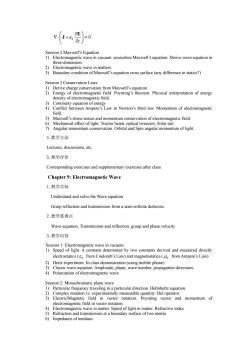
tcreee MalonDerive aven 2 Maxwell's equation Boundary sondition of Maxwell's equntion eross surfice (any difre sion 3 Con ervation Law 1)Derive charge conservation from Maxwell's equation 2)Ene rgy of lectromagnetic d.Poyning horem.Physeal interpretation of n equation of ener onflict between Ampere's Law to Newton's third law.Momentum of electromagnetic well's stre ation of electr Mechanical effect of light.Tractor bea 7) Angular momentum conservation.Orbital and Spin angular momentum of light 4.教学方法 Lectures,discussions,etc. 5.教学评价 Corresponding exercises and supplementary exercises afer clas Chapter 9:Electromagnetic Wave 1.教学目标 Understand and solve the Wave equation Grasp reflection and transmission from a semi-infnitedielectric 2.教学重难点 Wave equation.Transmission and reflection,group and phase velocity 3.教学内容 electrostatics(from Coulomb's Law)and magnetostatics(from Ampere's Law) nstation(st one ave equation amplitude pha propagation directions. 4)Polarization of electromagnetic wave Session 2:Monochromatic plane wave 1)Particular fr quency traveling in a particular direction.Helmholtz equation. ag Ref 6)Impedance of medium
0 0 t E J Session 2 Maxwell’s Equation 1) Electromagnetic wave in vacuum: sourceless Maxwell’s equation. Derive wave equation in three-dimension. 2) Electromagnetic wave in matters. 3) Boundary condition of Maxwell’s equation cross surface (any difference to statics?) Session 3 Conservation Laws 1) Derive charge conservation from Maxwell’s equation 2) Energy of electromagnetic field. Poynting’s theorem. Physical interpretation of energy density of electromagnetic field. 3) Continuity equation of energy 4) Conflict between Ampere’s Law to Newton’s third law. Momentum of electromagnetic field. 5) Maxwell’s stress tensor and momentum conservation of electromagnetic field. 6) Mechanical effect of light. Tractor beam, optical tweezers, Solar sail. 7) Angular momentum conservation. Orbital and Spin angular momentum of light. 4.教学方法 Lectures, discussions, etc. 5.教学评价 Corresponding exercises and supplementary exercises after class. Chapter 9: Electromagnetic Wave 1.教学目标 Understand and solve the Wave equation Grasp reflection and transmission from a semi-infinite dielectric 2.教学重难点 Wave equation, Transmission and reflection, group and phase velocity 3.教学内容 Session 1: Electromagnetic wave in vacuum 1) Speed of light. A constant determined by two constants derived and measured directly electrostatics ( 0 from Coulomb’s Law) and magnetostatics ( 0 from Ampere’s Law) 2) Hertz experiment. In class demonstration (using mobile phone) 3) Classic wave equation. Amplitude, phase, wave number, propagation directions. 4) Polarization of electromagnetic wave Session 2: Monochromatic plane wave 1) Particular frequency traveling in a particular direction. Helmholtz equation. 2) Complex notation vs. experimentally measurable quantity. Del operator. 3) Electric/Magnetic field in vector notation. Poynting vector and momentum of electromagnetic field in vector notation. 4) Electromagnetic wave in matter. Speed of light in matter. Refractive index 5) Refraction and transmission at a boundary surface of two media 6) Impedance of medium
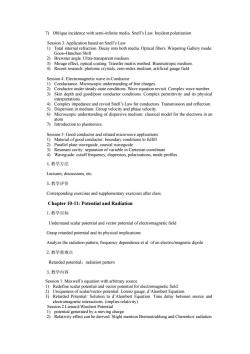
7)Oblique incidence with semi-infinite media Snell's Law.Incident polarization Session 3:Application based on Snell's Law 1)Total in nal refraction.Decay into both media.Optical fibers.Wispering Gallery mode. anche ect optical coating Transfer maix method Bianisotrone 4)Recent research:photonic crystals.zero-index medium.artificial gauge field Session 4:Electromagnetic wave in Conductor Conductance copic underst nding of free cha Skin depth and g interpretations 9 6)Microscopic understanding of dispersive medium:classical model for the electrons in an 7)ito duction to plasmonics 2)Parallel plate waveguide.coaxial waveguide ariable in C siancordnee de profile 4,教学方法 Lectures,discussions.etc 5.教学评价 Corresponding exercises and supplementary exercises after class Chapter 10-11:Potential and Radiation 1.教学目标 Understand scalar potential and vector potential ofelectromagnetic field Grasp retarded potential and its physical implications Analyze the radiation pattern,frequency dependence et al.of an electric/magnetic dipole 2.教学重难点 Retarded potentil:radiation patter 3.教学内容 etic field ector potential.Loren uge.d'Alember Equation. Retarded Potentia quation.Time delay between source and Session 2 Lienard-Wiechert Potential mention Bremsstrahlung and Cherenkov radiation
7) Oblique incidence with semi-infinite media. Snell’s Law. Incident polarization Session 3: Application based on Snell’s Law 1) Total internal refraction. Decay into both media. Optical fibers. Wispering Gallery mode. Goos–Hänchen Shift 2) Brewster angle. Ultra-transparent medium. 3) Mirage effect, optical coating. Transfer matrix method. Bianisotropic medium. 4) Recent research: photonic crystals, zero-index medium, artificial gauge field Session 4: Electromagnetic wave in Conductor 1) Conductance. Microscopic understanding of free charges. 2) Conductor under steady-state conditions. Wave equation revisit. Complex wave number. 3) Skin depth and good/poor conductor conditions. Complex permittivity and its physical interpretations. 4) Complex impedance and revisit Snell’s Law for conductors. Transmission and reflection. 5) Dispersion in medium. Group velocity and phase velocity. 6) Microscopic understanding of dispersive medium: classical model for the electrons in an atom 7) Introduction to plasmonics. Session 5: Good conductor and related microwave applications 1) Material of good conductor: boundary conditions to fulfill 2) Parallel plate waveguide, coaxial waveguide 3) Resonant cavity: separation of variable in Cartesian coordinate 4) Waveguide: cutoff frequency, dispersion, polarizations, mode profiles 4.教学方法 Lectures, discussions, etc. 5.教学评价 Corresponding exercises and supplementary exercises after class. Chapter 10-11: Potential and Radiation 1.教学目标 Understand scalar potential and vector potential of electromagnetic field Grasp retarded potential and its physical implications Analyze the radiation pattern, frequency dependence et al. of an electric/magnetic dipole 2.教学重难点 Retarded potential;radiation pattern 3.教学内容 Session 1: Maxwell’s equation with arbitrary source 1) Redefine scalar potential and vector potential for electromagnetic field. 2) Uniqueness of scalar/vector potential. Lorenz gauge. d’Alembert Equation. 3) Retarded Potential: Solution to d’Alembert Equation. Time delay between source and electromagnetic interactions. (implies relativity) Session 2 Lienard-Wiechert Potential 1) potential generated by a moving charge 2) Relativity effect can be derived. Slight mention Bremsstrahlung and Cherenkov radiation
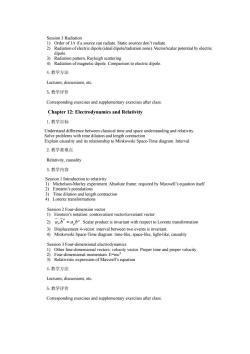
2)Radiation ofelectric dipole(ideal dipole/radiation zone).Vector/scalar potential by electric )Rcaenwttpt 4.教学方法 Lectures,discussions,ete 5.教学评价 Corresponding exercises and supplementary exercises afer class Chapter 12:Electrodynamics and Relativity 1.教学目标 understanding and relativity Explain causality and its relationship to Minkowski Space-Time diagram.Interval. 2.教学重难点 Relativity,causality 3.教学内容 ions 2)=Scalar product is invariant with respect to Lorentz transformation 3)Displacement 4-vector.interval between two events is invariant. 4)Minkowski Space-Time diagram:time-like,space-like,light-like:causality Session 3 Four-dimensional electrodynamics heotveor Poper time and proper vloity ell's equation 4.教学方法 Lectures,discussions,etc. 5.教学评价 Corresponding exercises and supplementary exercises after class
Session 3 Radiation 1) Order of 1/r if a source can radiate. Static sources don’t radiate. 2) Radiation of electric dipole (ideal dipole/radiation zone). Vector/scalar potential by electric dipole 3) Radiation pattern, Rayleigh scattering 4) Radiation of magnetic dipole. Comparison to electric dipole. 4.教学方法 Lectures, discussions, etc. 5.教学评价 Corresponding exercises and supplementary exercises after class. Chapter 12: Electrodynamics and Relativity 1.教学目标 Understand difference between classical time and space understanding and relativity. Solve problems with time dilation and length contraction Explain causality and its relationship to Minkowski Space-Time diagram. Interval. 2.教学重难点 Relativity, causality 3.教学内容 Session 1 Introduction to relativity 1) Michelson-Morley experiment. Absolute frame: required by Maxwell’s equation itself 2) Einstein’s postulations 3) Time dilation and length contraction 4) Lorentz transformations Session 2 Four-dimension vector 1) Einstein’s notation: contravariant vector/covariant vector 2) a b ab . Scalar product is invariant with respect to Lorentz transformation 3) Displacement 4-vector. interval between two events is invariant. 4) Minkowski Space-Time diagram: time-like, space-like, light-like; causality Session 3 Four-dimensional electrodynamics 1) Other four-dimensional vectors: velocity vector. Proper time and proper velocity 2) Four-dimensional momentum. E=mc2 3) Relativistic expression of Maxwell’s equation 4.教学方法 Lectures, discussions, etc. 5.教学评价 Corresponding exercises and supplementary exercises after class
按次数下载不扣除下载券;
注册用户24小时内重复下载只扣除一次;
顺序:VIP每日次数-->可用次数-->下载券;
- 苏州大学:物理科学与技术学院物理学专业《理论力学》课程教学大纲(英文).pdf
- 苏州大学:物理科学与技术学院物理学专业《理论力学》课程教学大纲.pdf
- 苏州大学:物理科学与技术学院物理学专业《热力学与统计物理》课程教学大纲.pdf
- 苏州大学:物理科学与技术学院物理学专业《热学》课程教学大纲.pdf
- 苏州大学:物理科学与技术学院物理学专业《普通物理实验》课程教学大纲(二).pdf
- 苏州大学:物理科学与技术学院物理学专业《普通物理实验》课程教学大纲(三).pdf
- 苏州大学:物理科学与技术学院物理学专业《普通物理实验》课程教学大纲(一).pdf
- 苏州大学:物理科学与技术学院物理学专业《电磁学》课程教学大纲.pdf
- 苏州大学:物理科学与技术学院物理学专业《普通物理》课程教学大纲(普通物理I——力学、波动).pdf
- 苏州大学:物理科学与技术学院物理学专业《电动力学》课程教学大纲.pdf
- 苏州大学:物理科学与技术学院物理学专业《STEAM-物理创新实验与设计》课程教学大纲.pdf
- 苏州大学:物理科学与技术学院物理学专业《热学》课程教学大纲(英文).pdf
- 苏州大学:物理科学与技术学院物理学专业《现代物理学在创新创业中的应用》课程教学大纲.pdf
- 苏州大学:物理科学与技术学院物理学专业《近代物理实验》课程教学大纲.pdf
- 苏州大学:物理科学与技术学院物理学专业《光学》课程教学大纲.pdf
- 苏州大学:物理科学与技术学院物理学专业《电工学》课程教学大纲.pdf
- 苏州大学:物理科学与技术学院物理学专业《热力学与统计物理》课程教学大纲(英文).pdf
- 苏州大学:物理科学与技术学院物理学专业《模拟电路》课程教学大纲.pdf
- 苏州大学:物理科学与技术学院物理学专业《数字电路》课程教学大纲.pdf
- 苏州大学:物理科学与技术学院物理学专业《薄膜技术与纳米材料》课程教学大纲(英文).pdf
- 苏州大学:物理科学与技术学院物理学专业《半导体物理与器件》课程教学大纲.pdf
- 苏州大学:物理科学与技术学院物理学专业《固体物理》课程教学大纲(英文).pdf
- 苏州大学:物理科学与技术学院物理学专业《计算物理》课程教学大纲.pdf
- 苏州大学:物理科学与技术学院物理学专业《材料化学》课程教学大纲.pdf
- 苏州大学:物理科学与技术学院物理学专业《太阳能电池原理与技术》课程教学大纲.pdf
- 苏州大学:物理科学与技术学院物理学专业《物性表征方法》课程教学大纲.pdf
- 苏州大学:物理科学与技术学院物理学专业《太阳能电池材料与制备技术》课程教学大纲.pdf
- 苏州大学:物理科学与技术学院物理学专业《数学物理方法》课程教学大纲.pdf
- 苏州大学:物理科学与技术学院物理学(师范)专业《中学物理解题方法》课程教学大纲.pdf
- 苏州大学:物理科学与技术学院物理学(师范)专业《中学物理教学法实验》课程教学大纲.pdf
- 苏州大学:物理科学与技术学院物理学(师范)专业《演示实验》课程教学大纲.pdf
- 苏州大学:物理科学与技术学院物理学(师范)专业《中学物理实验研究》课程教学大纲.pdf
- 苏州大学:物理科学与技术学院物理学(师范)专业《原子物理学》课程教学大纲.pdf
- 苏州大学:物理科学与技术学院物理学(师范)专业《数学物理方法》课程教学大纲.pdf
- 苏州大学:物理科学与技术学院物理学(师范)专业《电工学》课程教学大纲.pdf
- 苏州大学:物理科学与技术学院物理学(师范)专业《现代物理学在创新创业中的应用》课程教学大纲.pdf
- 苏州大学:物理科学与技术学院物理学(师范)专业《近代物理实验》课程教学大纲.pdf
- 苏州大学:物理科学与技术学院物理学(师范)专业《光学》课程教学大纲.pdf
- 苏州大学:物理科学与技术学院物理学(师范)专业《STEAM-物理创新实验与设计》课程教学大纲.pdf
- 苏州大学:物理科学与技术学院物理学(师范)专业《教育实习》课程教学大纲.pdf
